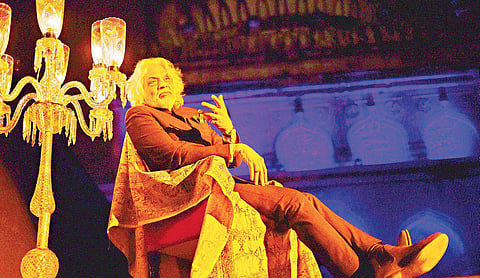

HYDERABAD: It takes the majesty of Qutb Shahi Tombs to magnify the saga of historical tales picked, polished and presented on silver screen, and it takes the genius of a filmmaker like Muzaffar Ali to hold onto its grandeur while narration of a cluster of anecdotes is interwoven on the massive stage. The bulbous dome towered over the narrative parts of which were shown on screens installed below. The crisp winter evening set the mood for ‘Weaver of Dreams – The Passion of Muzaffar Ali of Kotwara’: a saga unfolding the embroidery of cinematic sequences interspersed with the snippets that he shared as journalist-biographer Sathya Saran rendered the required background of the Nawab’s several endeavours.
It was his roots in royal house of Kotwara, Awadh that made Muzaffar delve deep into historical fiction of Lucknow and present to the world the powerful role of a courtesan-poet against the backdrop of the Great Revolt of 1857. That’s how he immortalised Umrao Jaan on the screen featuring actor Rekha in the lead. He reminisced, “The book ‘Umrao Jaan Ada’ written by poet-author Mirza Hadi Ruswa in 1899 enticed me so much that I wanted to resuscitate the same in cinema.
The kingdom of Awadh and its several stories appeared before me in fragments,” he sewed together the same into his magnum opus woven with the 1857 Mutiny. “The courtesan Umrao from Faizabad made for a strong character who’s equally vulnerable while she’s duped by her seekers and lovers,” he added. She was symbolic of Hindustan exploited by her suitors. The characters dressed in opulent attire and jewels paradoxically depicted a decadent nation headed for its own downfall. The decay of the country rhymed with the musical renditions of Khayyam, the movie’s music director. The personification of the same captured through dance by Kathak danseuse Astha Dixit to the tunes of the ghazal: In Ankhon Kii Masti kay…
It’s not just the character of Umrao Jaan that he explored layer by layer in the famous movie, he also ventured up north in Kashmir to bring onto screen the life of 16th century Kashmiri mystic poetess and ascetic Habba Khatoon in his 1989 dream film Zooni. The lead role was played Dimple Kapadia. The ethereal beauty Habba was known as Zooni across the valley given zoon or zooni means moon in Kashmiri. Muzaffar had chosen the
American designer Mary McFadden for dress design; for historical consultation he had selected art historian Stuart Cary Welch. Several portions of the movie were shot in the valley, but could never be finished – thanks to the political unrest and personal setbacks in the director’s life. On being asked if he’d like to release portions of the movie, Muzaffar lamented, “Ab Zooni ke liye toh aap du’a hii kar sakte hain.”
If up north there was Zooni, down south, Deccan had its own moon: the 18th century courtesan-poet Mah Laqa bai Chanda known for her beauty and political wisdom whose counsel was sought even by the Nizam. We asked if he’d like to make a movie on the poetess now faded in oblivion the director-couturist answered, “Why not? Of course, we can make a movie on her. Hyderabad badi zabardast jagah hai, bahot kuch kar sakte hain yehaan. Zaroor karenge. I’d love to make a movie on Maha.”
The stage glittered with models emerging in ethnic ensembles and as their attires mingled with the dark evening, the owner of the fashion label Kotwara continued being the raconteur of his memories with the flow punctuated only by the clippings of his movies Gaman, Umrao Jaan and the upcoming series Dastan-e-Dastkari: a composition of different tales of artisans and weavers in the country.
Running fingers into the mop of his white mane upset by the chilly wind he shared, “Thousands of people are engaged in this and their tales have to be told. The clothes they make should be felt when worn. The younger generation needs to develop an affinity for textiles. But today everyone is wearing machine-made clothes looking all alike. Sab daam ke ghulam hain!” The documentary is yet to release. He has shot six 15-minute short films on textiles and four on Banaras with a series on Pochampally. His poetry in textile continues with six more small films that he’s yet to shoot.